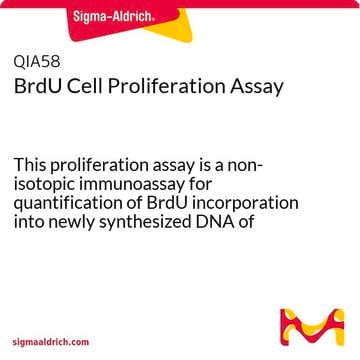11647229001
Roche
Cell Proliferation ELISA, BrdU (colorimetric)
sufficient for ≤1,000 tests
Synonim(y):
cell proliferation
About This Item
Polecane produkty
zastosowanie
sufficient for ≤1,000 tests
Poziom jakości
producent / nazwa handlowa
Roche
metody
ELISA: suitable
metoda wykrywania
colorimetric
temp. przechowywania
2-8°C
Powiązane kategorie
Opis ogólny
Specyficzność
Zastosowanie
The Cell Proliferation ELISA, BrdU (colorimetric) belongs to the second, improved generation of kits for measuring DNA synthesis. It is a precise, fast, and simple colorimetric alternative to quantitate cell proliferation based on the measurement of BrdU incorporation during DNA synthesis in replicating (cycling) cells. Thus, the Cell Proliferation ELISA can be used in many different in vitro cell systems. For example:
- Detection and quantification of cell proliferation induced by growth factors and cytokines
- Determination of the inhibitory or stimulatory effects of various compounds on cell proliferation in environmental and biomedical research, and in the food, cosmetic, and pharmaceutical industries
- Measurement of the immunoreactivity of lymphocytes, stimulated by mitogens or antigens
- Analysis of the chemosensitivity of tumor cells to different cytostatic drugs in medical research
- Testing of biocompatibility of various scaffolds, employed in bone tissue engineering, for bone cell growth
Opakowanie
Uwaga dotycząca przygotowania
Working solution: BrdU labeling solution
Dilute BrdU labeling reagent 1:100 with sterile culture medium (resulting concentration: 100 μM BrdU).
For one 96-well MP, 1 ml BrdU labeling solution is required if the cells were cultured in 100 μl /well (10 μl/well) and 2 ml BrdU labeling solution is required if the cells were cultured in 200 μl/well (20 μl/well).
Anti-BrdU-peroxidase stock solution
Dissolve Anti-BrdU-peroxidase in 1.1 ml double-dist. water for 10 minutes and mix thoroughly.
Anti-BrdU-peroxidase working solution
Dilute Anti-BrdU-peroxidase stock solution 1:100 with antibody dilution solution. For one 96-well MP dilute 100 μl Anti-BrdU-peroxidase stock solution in 10 ml antibody dilution solution
Washing solution
Dilute Washing buffer concentrate 1:10 with double-dist. water.
For one 96-well MP dilute 10 ml Washing buffer concentrate with 90 ml double-dist. water.
Storage conditions (working solution): BrdU labeling solution
The undiluted BrdU labeling reagent (1000x): At 2 to 8 °C for several months protected from light.
The diluted BrdU labeling reagent: At 2 to 8 °C stable for several weeks. Store protected from light. For long-term storage it is recommended to store the BrdU labeling solution in aliquots at -15 to -25 °C.
Anti-BrdU-peroxidase stock solution
At 2 to 8 °C for several months. For long-term storage it is recommended to store the solution in aliquots at -15 to -25 °C.
Anti-BrdU-peroxidase working solution
Prepare shortly before use. Do not store.
Washing solution
At 2 to 8 °C for several weeks.
Rekonstytucja
Inne uwagi
Tylko elementy zestawu
- BrdU Labeling Reagent
- FixDenat ready-to-use
- Anti-BrdU-peroxidase antibody
- Antibody Dilution Solution ready-to-use
- Washing Buffer PBS 10x concentrated
- Substrate Solution TMB ready-to-use
Hasło ostrzegawcze
Danger
Zwroty wskazujące rodzaj zagrożenia
Zwroty wskazujące środki ostrożności
Klasyfikacja zagrożeń
Eye Irrit. 2 - Flam. Liq. 2 - Muta. 1B - Skin Sens. 1
Kod klasy składowania
3 - Flammable liquids
Klasa zagrożenia wodnego (WGK)
WGK 1
Certyfikaty analizy (CoA)
Poszukaj Certyfikaty analizy (CoA), wpisując numer partii/serii produktów. Numery serii i partii można znaleźć na etykiecie produktu po słowach „seria” lub „partia”.
Masz już ten produkt?
Dokumenty związane z niedawno zakupionymi produktami zostały zamieszczone w Bibliotece dokumentów.
Klienci oglądali również te produkty
Produkty
Cell cycle regulates vital processes like DNA repair, cancer prevention. Four stages: G1, S, G2, M. NTPs don't permeate membranes.
Cell based assays for cell proliferation (BrdU, MTT, WST1), cell viability and cytotoxicity experiments for applications in cancer, neuroscience and stem cell research.
Testy komórkowe do proliferacji komórek (BrdU, MTT, WST1), żywotności komórek i eksperymentów cytotoksyczności do zastosowań w badaniach nad rakiem, neuronauką i komórkami macierzystymi.
Protokoły
Cell Proliferation ELISA, BrdU (colorimetric) Protocol & Troubleshooting
Nasz zespół naukowców ma doświadczenie we wszystkich obszarach badań, w tym w naukach przyrodniczych, materiałoznawstwie, syntezie chemicznej, chromatografii, analityce i wielu innych dziedzinach.
Skontaktuj się z zespołem ds. pomocy technicznej













